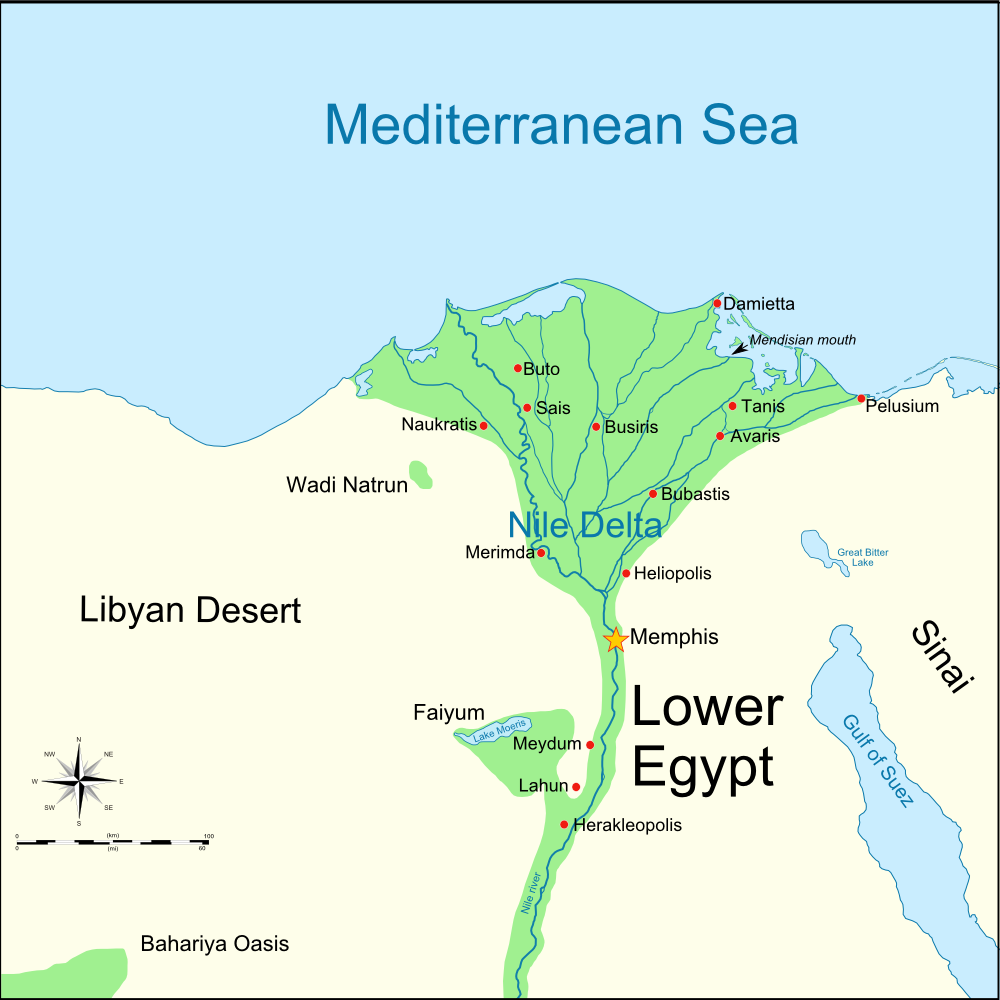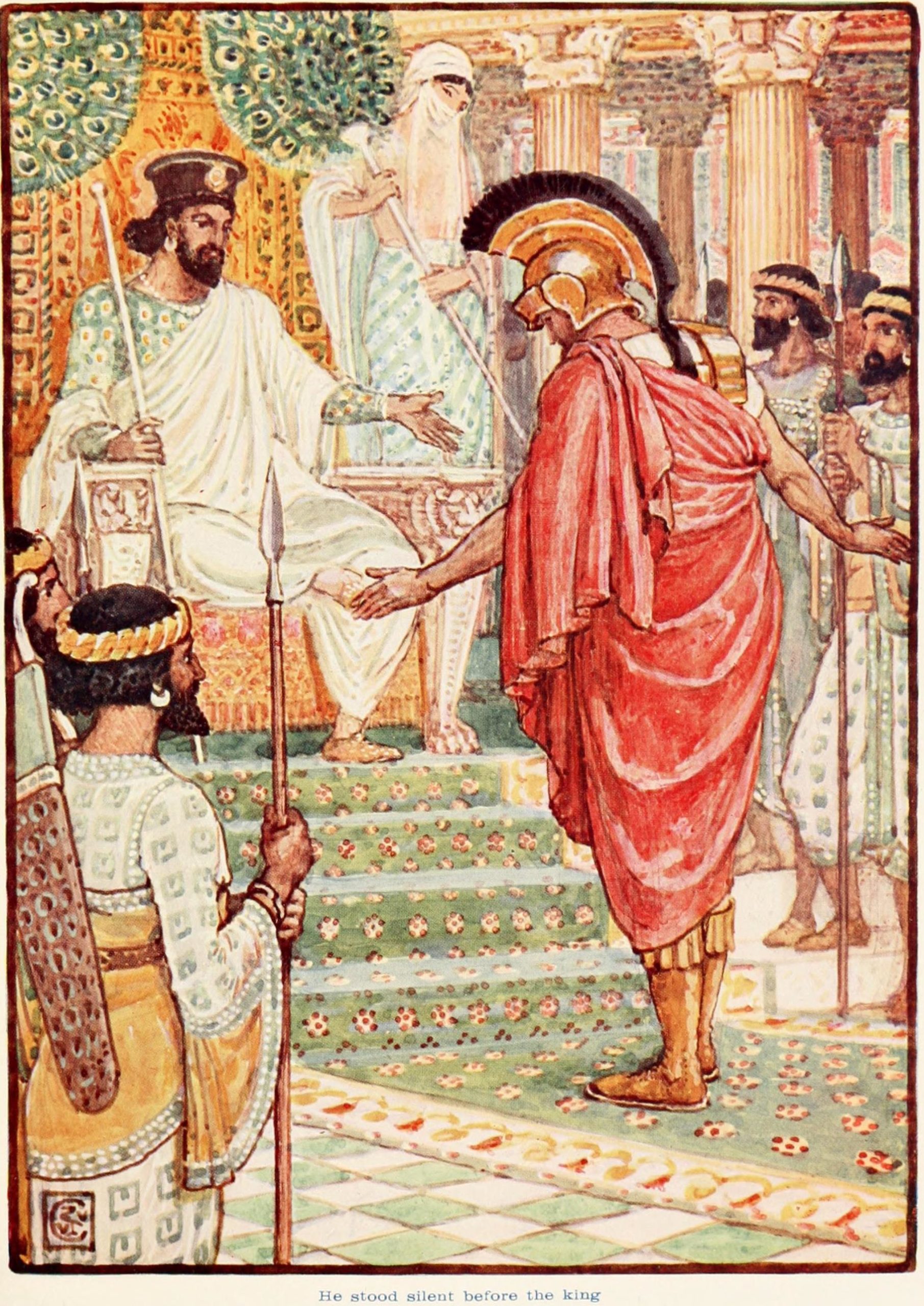In 460 BCE the Athenians were underway to carry out a mission—a raid on Cyprus to collect some more of the treasures of that island—when they was ordered by Perikles, after a voting process in Athens, to divert his fleet to Egypt.[1] The objective was to give naval support to the Libyan ruler Inaros II, who was leading a revolt against the Persian presence in that area. Charitimides led the 200 Athenian and allied triremes that were under his command and sailed into the delta of the river Nile.[2] There they made themselves master of the river, but only after having won a great battle against the Persians.

Artaxerxes, the son of Xerxes I and grandson of Darius I, was King of the Persian Empire since 465 BCE, the year that his father was murdered. The war between the Persians and the Greeks had been at a relative stand-still since the Battle of the Eurymedon in 469 BCE. Artaxerxes had maintained a strategy of weakening the Athenians by funding their enemies in Greece, mainly Sparta. After the death of his father, however, the Egyptians, led by Inaros had decided to revolt against the Persians and fight for their liberty.[3] Meanwhile, this same Artaxerxes had offered asylum to Themistocles, who had been his father Xerxes’s greatest enemy.[4]

Artaxerxes had sent his brother Achaemenides to Egypt[5], “with 400,000 infantry and eighty ships. Inarus joined battle with Achaemenides, the Egyptians were victorious, Achaemenides being slain by Inarus and his body sent to Artaxerxes.” (Ctisias Persica 36, tr. Freese). Inaros joined battle with the Persians and was victorious, and to make his point he sent the body of the mutilated Achaemenides back to Artaxerxes. Not completely sure of the durability of his victory, Inaros then made an alliance with the Greeks and this is where, in 460 BCE, the Athenian commander Charitimides came into sight. With a contingent of forty Athenian ships against fifty Persian ships, he covered himself with glory in a naval engagement, in which twenty out of the fifty Persian ships were captured with their crews, and the remaining thirty sunk.[6] After that, the Athenians made themselves master of the river and captured the best part of Memphis. Together with the Egyptians, they prepared to attack the remaining part, which was called the White Castle, which was the hiding place for the Persians and Medes, and for the Egyptians who had not joined the rebellion.[7]
Despite the availability of 6,000 heavy infantry, the siege of Memphis lasted and lasted.[8] After four years the Persians returned: “The king then sent Megabyzus against Inarus, with an additional army of 200,000 men and 300 ships commanded by Oriscus; so that, not counting the ships’ crews, his army consisted of 500,000. For, when Achaemenides fell, 100,000 of his 400,000 men perished.” .[9] The Greeks then retreated to their ships, which were moored on the island of Prosoptis in the Nile delta.[10]
Megabyzus laid siege to Prosoptis for 18 months, until he was able to connect the island to the Egyptian mainland, by digging canals and draining the river. The Persians then crossed over to the former island and captured it.[11] In 455 BCE, the Egyptian revolt was defeated and the greater part of the Greeks, including Charitimides, were captured. Only a few of the Athenian force survived and were able to march through Libya to Kyrene, from where they returned to Athens. Modern estimates place the figure of the lost Greeks at 50,000 men and 250 ships, including reinforcements.[12] In Athens, these events caused a great panic and were the public reason to move the Delian treasury to Athens[13].
The Persians then sent a fleet to Cyprus, to re-establish their control over that island, but Athens decided to counter them with a naval force of 200 ships under the command of the conservative Kimon. Kimon, who had returned from ostracism in 451 BCE, won a double victory, by land and by sea, over the Persians at Salamis (Cyprus). However, he died during the blockade of Citium.[14] The life of Inaros, the Libyan king whose rebellion was at the root of the disastrous Athenian expedition, had been spared by the Persians for five years, but in 450 BCE he was given to the Persian queen-mother Amytis, who had him impaled in vengeance for his killing of her son Achaemenes.[15]

After this, an understanding was reached between the Persians and Athens, enabling Pericles to focus his attention to the events in Greece. The Athenian demagogues provoked and incited the fighting against fellow Hellenes; the ones who had earlier helped them to block the Persian invasions. Many years later, the Athenian hegemony would collapse and by that time the Persians had recovered for a new series of attacks.
“After his [= Kimon’s] death no further brilliant exploit against the Barbarians [= Persians] was performed by any general of the Hellenes, who were swayed by demagogues and partisans of civil war, with none to hold a mediating hand between th em, till they actually clashed together in war. This afforded the cause of the [Persian] King a respite but brought to pass an indescribable destruction of Hellenic power”.[16]
Notes
1 Thucydides, The Peloponnesian War 1.104, 109–110.
Aird, Hamish. 2004. Pericles: The Rise and Fall of Athenian Democracy. New York.
Diodorus Siculus, The Library of History 11.71, 11.74.
2 Inaros had his headquarters in the western extremity of Egypt’s Nile delta, in a nome (district of land) on the shore of Lake Marea, or Mareotis, a town above Pharos, famous for its lighthouse. (Thucydides 1.104). Ctesias mentions that forty ships were sent by the Athenians (section 36).
3 Diodorus 11.71.
4 Thucydides 1.137–138
5 Diodorus 11.74.1 gives a lower figure of 300,000 soldiers (infantry and cavalry).
6 Ctesias Persica 36 gives these figures. The total number of Athenian ships given in Diodoruss 11.74 is 200.
7 Diodorus 11.74.4.
8 Thucydides 1.110
9 Ctisias Persica 37.
10 Thucydides 1.109. Meanwhile, back at home in Greece, around 458 BCE, the island of Aegina surrendered to Athens and was forced to join the Delian League. (Thucydides 1.108)
11 Thucydides 1.109
12 Modern estimates from Wikipedia article on Megabyzus, which gives as its reference Ray, Fred (1949). Land Battles in 5th Century BC Greece: A History and Analysis of 173 Engagements. McFarland & Company, Inc. pp. 109–110., mentioning 25,000 (again another number)
13 Encyclopaedia Britannica: “Delian League” The date given for this is 454. Wikipedia makes reference to Athenian Finance and the Treasury of Athena, Loren J. Samons II at https://www.jstor.org/stable/4436281?seq=1
14 Plutarch The Life of Cimon 18–19.
15Thucydides 1.110, Ctisias Persica 39.
16 Plutarch, The Life of Cimon 19.
Texts accessed October 2020.
Bibliography
Ctesias, Persica. Photius’ Excerpt of Ctesias’ Persica. Translation by J.H. Freese. Online at Livius.org
Image credits
Figure 1: Map of Egypt showing relevant locations, where known, to the Delian league campaign of 460–454 BCE.
Jeff Dahl. Creative Commons CC BY-SA 3.0, Wikimedia Commons
Figure 2: Crane, Walter. c1910. Themistocles stands silently before Artaxerxes. Illustration from Macgregor, Mary: The story of Greece: told to boys and girls. Public domain, Wikimedia Commons
Figure 3: Inarus and possible Greek generals as prisoners, seized by Artaxerxes I. Image from page 45 of Martin, Richard A. “Ancient seals of the Near East” (1940). No known copyright restrictions, Wikimedia Commons.
Images accessed October 2020.
___
Rien is a member of Kosmos Society.